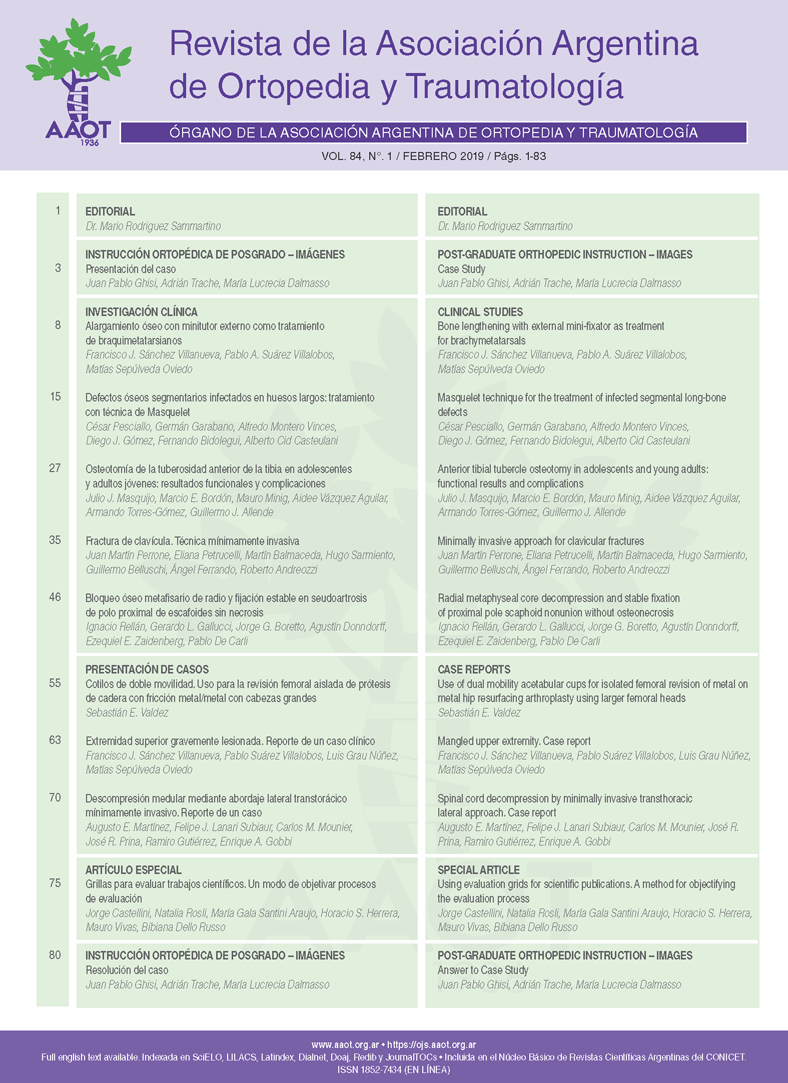Osteotomía de la tuberosidad anterior de la tibia en adolescentes y adultos jóvenes: resultados funcionales y complicaciones. [Anterior tibial tubercle osteotomy in adolescents and young adults: functional results and complications]
Contenido principal del artículo
Resumen
Descargas
Métricas
Detalles del artículo

Esta obra está bajo licencia internacional Creative Commons Reconocimiento-NoComercial-CompartirIgual 4.0.
La aceptación del manuscrito por parte de la revista implica la no presentación simultánea a otras revistas u órganos editoriales. La RAAOT se encuentra bajo la licencia Creative Commons 4.0. Atribución-NoComercial-CompartirIgual (http://creativecommons.org/licenses/by-nc-sa/4.0/deed.es). Se puede compartir, copiar, distribuir, alterar, transformar, generar una obra derivada, ejecutar y comunicar públicamente la obra, siempre que: a) se cite la autoría y la fuente original de su publicación (revista, editorial y URL de la obra); b) no se usen para fines comerciales; c) se mantengan los mismos términos de la licencia.
En caso de que el manuscrito sea aprobado para su próxima publicación, los autores conservan los derechos de autor y cederán a la revista los derechos de la publicación, edición, reproducción, distribución, exhibición y comunicación a nivel nacional e internacional en las diferentes bases de datos, repositorios y portales.
Se deja constancia que el referido artículo es inédito y que no está en espera de impresión en alguna otra publicación nacional o extranjera.
Por la presente, acepta/n las modificaciones que sean necesarias, sugeridas en la revisión por los pares (referato), para adaptar el trabajo al estilo y modalidad de publicación de la Revista.
Citas
2. Glaviano NR, Kew M, Hart JM, Saliba S. Demographic and epidemiological trends in patellofemoral pain. Int J Sports Phys Ther 2015;10(3):281-90. https://www.ncbi.nlm.nih.gov/pmc/articles/PMC4458915/
3. Longo G, Rizzello G, Cuiffreda M, Loppini M, Baldari A, Maffulli N, Denaro V. Elmslie-Trillat, Maquet, Fulkerson, Roux Goldthwait and other distal realignment procedures for de management of patellar dislocation: systematic review and quantitative synthesis of the literature. Arthroscopy 2016;32(5):929-43. DOI: 10.1016/j. arthro.2015.10.019
4. Cox JS. An evaluation of the Elmslie-Trillat procedure for management of patellar dislocations and subluxations. A preliminary report. Am J Sports Med 1982;10(5):303- 10. DOI: 10.1177/036354657600400204
5. Hauser EDW. Total tendon transplant for slipping patella: a new operation for recurrent dislocation of the patella. Surg Gynec Obstet 1938; 66:199-214. DOI: 10.1097/01.blo.0000238831.50186.87
6. Maquet P. Advancement of the tibial tuberosity. Clin Orthop Relat Res 1976;115:225-30. DOI: 10.1097/00003086-197603000-00039
7. Fulkerson J, Becker G, Meaney J, Miranda M, Folik M. Anteromedial tibial tubercle transfer without bone graft.
Am J Sports Med 1990;8:490-7. DOI: 10.1177/036354659001800508
8. Feller J. Distal realignment (tibial tuberosity transfer). Sports Med Arthrosc Rev 2012;20:152-61. DOI: 10.1097/JSA.0b013e318262e8e7
9. Payne J, Rimmke N, Schmitt LC, Flanigan DC, Magnussen RA. The incidence of complications of tibial tubercle osteotomy: a systematic review. Arthroscopy 2015;31(9):1819-25.
DOI: 10.1016/j.arthro.2015.03.028
10. Bellemans J, Cauwenberghs F, Witvrouw E, Brys P, Victor J. Anteromedial tibial tubercle transfer in patients with chronic anterior knee pain and a subluxation-type patellar malalignment. Am J Sports Med 1997;25:375-81. DOI: 10.1177/036354659702500318
11. Shelbourne KD, Porter DA, Rozzi W. Use of a modified Elmslie-Trillat procedure to improve abnormal patellar congruence angle. Am J Sports Med 1994;22:318-23. DOI: 10.1177/036354659402200304
12. Tomatsu T, Imai N, Hanada T, Nakamura Y. Simplification of the Elmslie-Trillat procedure for patellofemoral malalignment. Is medial capsulorraphy necessary? Int Orthop 1996;20:211-5. DOI:10.1007/s002640050065
13. Tsuda E, Ishibashi Y, Yamamoto Y, Maeda S. Incidence and radiologic predictor of postoperative patellar instability after Fulkerson procedure of the tibial tuberosity for recurrent patellar dislocation. Knee Surg Sports Traumatol Arthrosc 2012;20:2062-70.
DOI: 10.1007/s00167-011-1832-2
14. Trillat A, Dejour H, Couette A. Diagnosis and treatment of recurrent dislocations of the patella. Rev Chir Orthop Reparatrice Appar Mot 1964;50:813-24.
15. Luhmann SJ, Fuhrhop S, O’Donnell JC, Gordon JE. Tibial fractures after tibial tubercle osteotomies for patellar instability: A comparison of three osteotomy configurations. J Child Orthop 2011;5:19-26. DOI: 10.1007/s11832-010-0311-5
16. Sink E, Leunig M, Zaltz I, Gilbert JC, Clohisy J. Reliability of a complication classification system for orthopaedic surgery. Clin Orthop Relat Res 2012;470:2220-6. DOI: 10.1007/s11999-012-2343-2
17. Schoettle PB, Zanetti M, Seifert B, Pfirrmann CW, Fucentese SF, Romero J. The tibial tuberosity-trochlear groove distance: a comparative study between CT and MRI scanning. Knee 2006;13(1):26-31. DOI: 10.1016/j.knee.2005.06.003
18. Masquijo JJ, Altube G, Ferreyra A, Allende V, Torres-Gómez A. Precisión de la resonancia magnética para la medición de la distancia TT-TG en adolescentes. Artroscopía 2013;20(1):7-10. https://www.revistaartroscopia.com/ediciones-anteriores/2013/volumen-20-numero-1/89-volumen-05-numero-1/volumen-20-numero-1/608-precision-dela-resonancia-magnetica-para-la-medicion-de-la-distancia-tt-tg-en-adolescentes
19. Miller TT, Staron RB, Feldman F. Patellar height on sagittal MR imaging of the knee. AJR Am J Roentgenol 1996;167:339-41. DOI: 10.2214/ajr.167.2.8686598
20. Kujala UM, Jaakkola LH, Koskinen SK, Taimela S, Hurme M, Nelimarkka O. Scoring of patellofemoral disorders. Arthroscopy 1993;9(2):159-63. DOI: 10.1016/S0749-8063(05)80366-4
21. Bengtsson J, Möllborg J, Werner S. A study for testing the sensitivity and reliability of the Lysholm knee scoring scale. Knee Surg Sports Traumatol Arthrosc 1996;4(1):27-31.
DOI: 10.1007/BF01565994
22. Tang JB. Re: Levels of experience of surgeons in clinical studies. J Hand Surg Eur 2009;34(1):137-8. DOI: 10.1177/17531934097321
23. Koeter S, Diks MJ, Anderson PG, Wymenga AB. A modified tibial tubercle osteotomy for patellar mal- tracking: Results at two years. J Bone Joint Surg Br 2007;89:180-5. DOI: 10.1302/0301-620X.89B2.18358
24. Shen H-C, Chao K-H, Huang G-S, Pan R-Y, Lee C-H. Combined proximal and distal realignment procedures to treat the habitual dislocation of the patella in adults. Am J Sports Med 2007;35:2101-8. DOI: 10.1177/0363546507305014
25. Sillanpää P, Mattila VM, Visuri T, Mäenpää H, Pihlajamäki H. Ligament reconstruction versus distal realignment for patellar dislocation. Clin Orthop Relat Res 2008;466:1475-84.
DOI: 10.1007/s11999-008-0207-6
26. Barber FA, McGarry JE. Elmslie-Trillat procedure for the treatment of recurrent patellar instability. Arthroscopy 2008;24:77-81.
DOI: 10.1016/j.arthro.2007.07.028
27. Benoit B, Laflamme GY, Laflamme GH, Rouleau D, Delisle J, Morin B. Long-term outcome of surgically-treated habitual patellar dislocation in children with coexistent patella alta. Minimum follow-up of 11 years. J Bone Joint Surg Br 2007;89:1172-7.
DOI: 10.1302/0301-620X.89B9.19065
28. Nakagawa K, Wada Y, Minamide M, Tsuchiya A, Moriya H. Deterioration of long-term clinical results after the Elmslie-Trillat procedure for dislocation of the patella. J Bone Joint Surg Br 2002;84:861-4. DOI: 10.1302/0301-620X.84B6.0840861
29. Tompkins M, Arendt EA. Complications in patellofemoral surgery. Sports Med Arthrosc 2012;20:187-93.
DOI: 10.1097/JSA.0b013e31825c74cf

